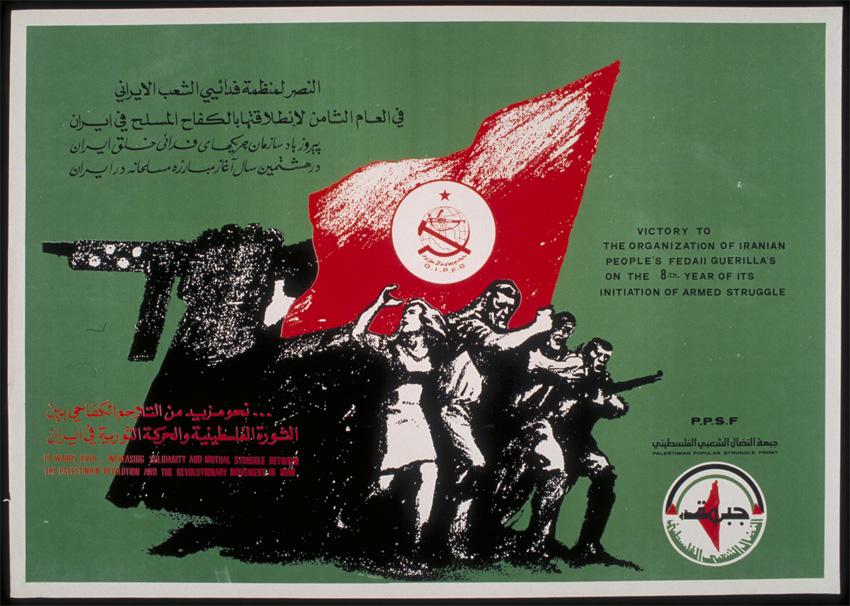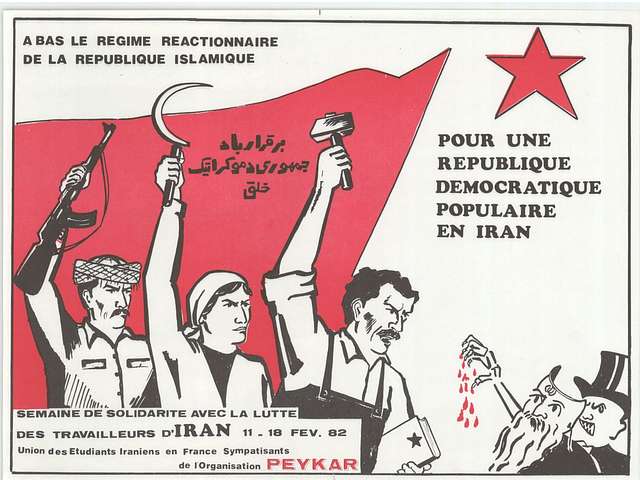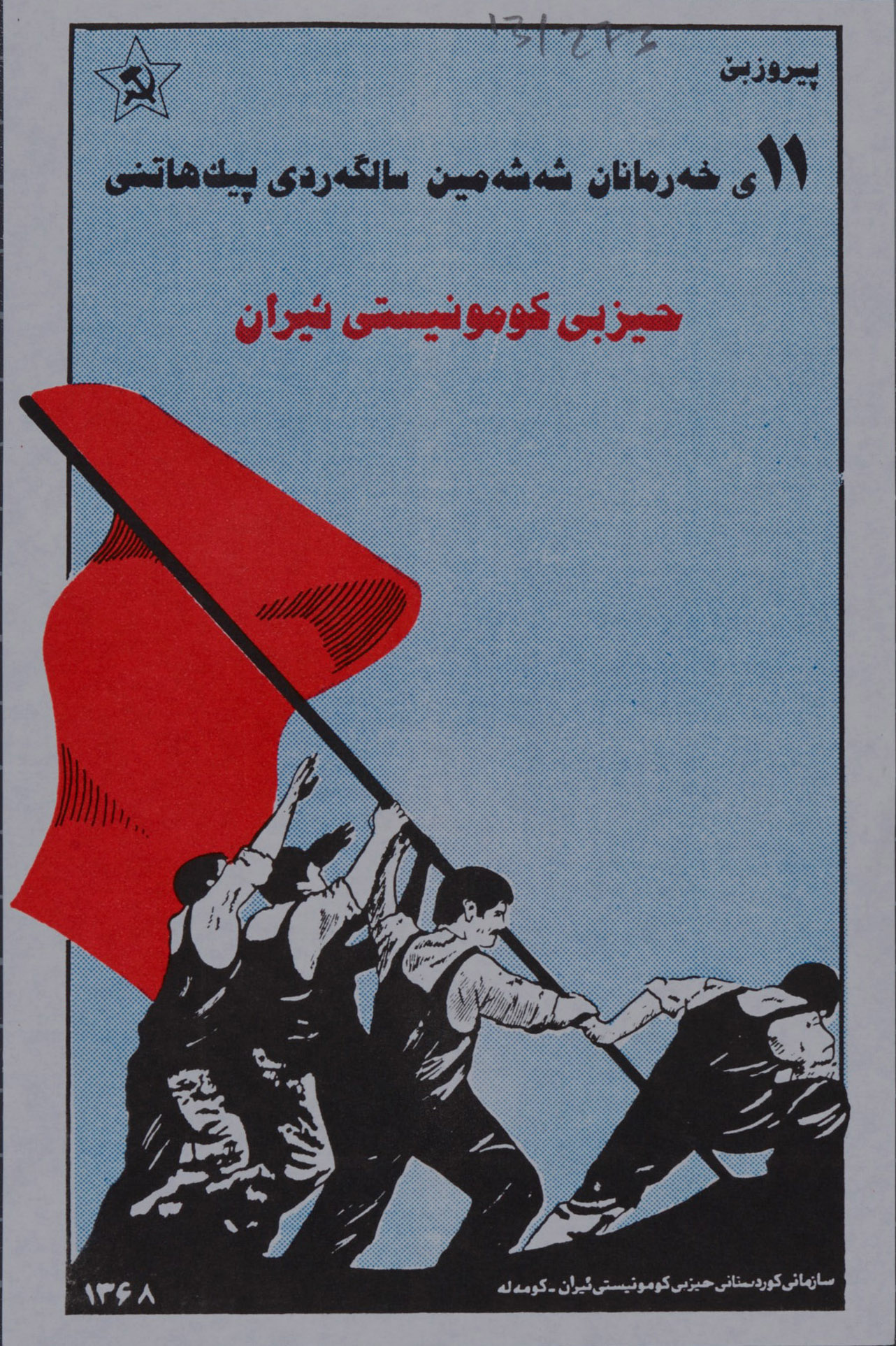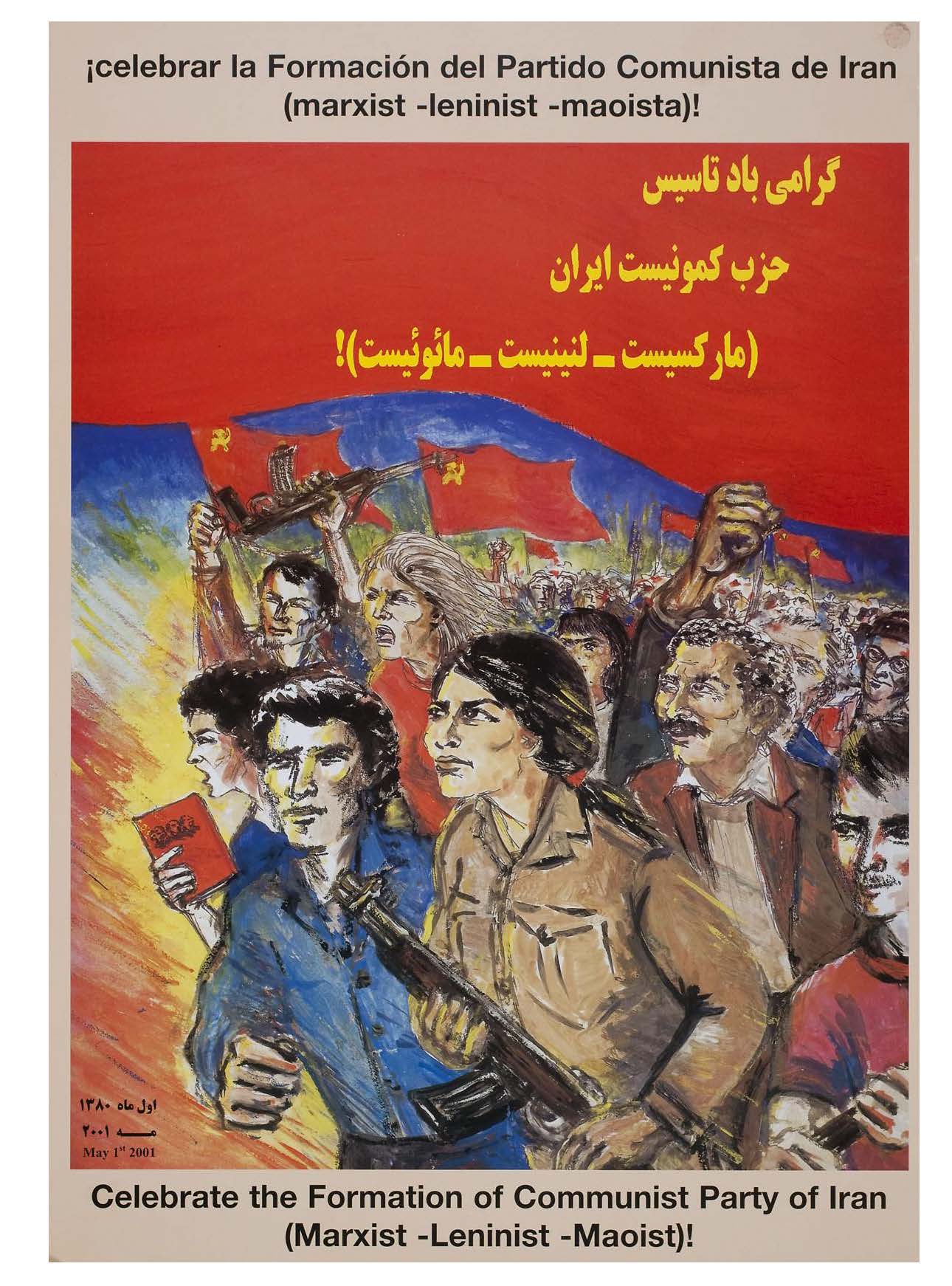
Family Tree of the Revolutionary Left in Iran
Iran Between Two Revolutions, Ervand Abrahamian, 1982
Brief History of the Communist Movement in Iran, 1900-1977, from Iran: the Struggle Within, No. 2, 1977
The Workingclass and the Islamic State in Iran Haideh Moghissi and Saeed Rahnema 2001
Masked Resistance: The Iranian Student Movement in the United States, 1977-1979 Andrea Nasrine Shahmohammadi 2008
Communism in Persia After 1953 Encyclopadeia Iranica, 2011
Notes on the Iranian left: lessons from the past Reza Zadeh, 2012
On the Alliance of the October League with the Shah of Iran, Iranian Student Association of the United States, 1975
In Support of the Iranian People's Revolutionary Movement. Commemorating the June 5, 1963 Uprising, Iranian Student Association of Northern California, 1977
Struggle, No. 6, May 1978 [Confederation of Iranian Students National Union]
Resistance, Vol. 5, No. 6, September 1978 [Iranian Student Association in the U.S.]
Resistance, Vol. 5, No. 7, October 1978 [Iranian Student Association in the U.S.]
Resistance, Vol. 6, No. 1, January 1979 [Iranian Student Association in the U.S.]
Information Iran, No. 2, May 1979 [Committee to Support the Struggle of the Iranian People]
Information Iran, No. 3, June 1979 [Committee to Support the Struggle of the Iranian People]
Condemn Zionist-Phalangist Massacre of Palestinians [Iranian Students Association] 1982
Fred Halliday says that in 1965 three members or alternate members of the Tudeh Party Central Committee (Ahmad Ghassemi, Gholamhussein Forutan and Abbas Seghai) launched an attack on what they perceived to be the revisionist character of Party policy. The following year, together with younger members of the Tudeh Party they founded the Revolutionary organization of the Tudeh (Sazman-i Inqilabi). As the Soviet-China split intensified, it adopted a pro-China orientation. The Proletarian Party of Iran (Ranjbaran) was formed in December 1979 from nine Marxist groups, mostly Maoist in orientation.
Iraninform, No. 2, August 1975
UNITY interviews a member of Ranjbaran Party. Iran today: An Iranian Marxist-Leninist View, Unity, Vol. 3, No. 13, June 24-July 3, 1980
Program of the Proletarian Party of Iran (Ranjbaran), October 2006
Intensification of the Ideological Struggle Within the Iranian Left Movement, K. Abraham, 2008
Communists and Social Movements, K. Abraham, 2009
Policy and Tactics are the Lifeblood of the Party, 2009
Is Communist Unity Based on Evolution or Synthesis?, K. Abraham, March 2011
It is Urgent to Oppose the Right and the Left Within the Workers' Movement, K. Ebrahim, September 2011
Commitment to Implementing Communist Theory, Practice and Work Methods (On the Occasion of the Anniversary of the October Revolution), K. Ebrahim, October 2, 2011
Once Again the Need For the Intensification of Ideological Struggle, K. Ebrahim, August 31, 2012
Only Dialectical Materialist Analysis of Every Phenomenon is Reliable, K. Ebrahim, November 29, 2013
[Back to top]
______________________
By one telling, in 1965, in the wake of the Sino-Soviet dispute, two senior members of the Tudeh Party Central Committee—Ghassemi and Forutan—left the Tudeh accusing it of revisionism and formed a new group called the Toufan Marxist-Leninist Organization. Fred Halliday, however, alleges that Toufan arose from a split in the Revolutionary Organization of the Tudeh Party. Originally Maoist in orientation Toufan (renamed the Party of Labour of Iran) later oriented itself toward Albania.
Hail the Second Anniversary of the Iranian Revolution!, Workers' Advocate, Vol. 11, No. 2, February 25, 1981
Representative of the Workers' and Peasants' Communist Party of Iran Addresses Internationalist Rally [in Montreal April 30th], Workers' Advocate, Vol. 8, No. 6, June 19, 1978
The Workers' and Peasants' Communist Party of Iran Strengthening Itself, 1978
The Workers' and Peasants' Communist Party of Iran Considers the Establishment of People's Councils as a Guarantee of Democracy, Workers' Advocate, Vol. 9, No. 6, July 1, 1979
Excerpts from the Report of the Enlarged Plenum of the Party of Labour of Iran, Part 1; Part 2; 2001
Materials from the Third Congress of the Party of Labour of Iran, Part 1; Part 2; Part 3; Part 4; Part 5 2004
Toufan, 1977-1978, 2003-2009
[Back to top]
______________________
The OIPFG was born in 1971 from the merger of two underground communist groups, the first consisting of remnants of the Siahkal group led by Safai Farahani and a second one led by Massoud Ahmad-Zadeh and Amir Parviz Pouyan. The group engaged in guerrilla warfare against the Shah’s regime and many of its activists were killed or captured. On the eve of the Islamic Revolution it numbered not more than a few dozen members, but its record of courageous action had attracted great sympathy, especially among young people, and in the enthusiasm immediately following the victorious Revolution tens of thousands of them joined, making it the largest communist organization in Iran. However, divisions soon emerged, including over how to evaluate the new Islamic regime, reform struggles, the Tudeh Party, etc. In June 1980 the organization split into majority and minority factions which then became separate organizations. The minority group continued to take anti-revisionist positions while the majority became increasingly pro-Soviet and pro-Tudeh. At the 6th conference of the O.I.P.F.G.(Minority) in Janunary 1997, the name of the organisation was changed to Organisation of Fadaian (Aghaliyat).
Family Tree of the Origins and Splits in the Iranian People's Fedaii Guerillas [from the book A Guerrilla Odyssey]
Iran's Fadayan 1971-1988: A Case Study in Iranian Marxism, Maziar Behrooz 1990
A Guerrilla Odyssey: Modernization, Secularism, Democracy, and the Fadai Period of National Liberation in Iran, 1971–1979, Peyman Vahabzadeh 2010
Devotion and resistance: Bizhan Jazani and the Iranian Fedaii, Doug Enaa Greene 2015
Fada’i Guerrilla Praxis in Iran (1970–1979) Narratives and Reflections on Everyday Life, Edited by Touraj Atabaki, Nasser Mohajer, and Siavush Randjbar-Daemi 2023

A Brief History of the Organization of Iranian People's Fedaii Guerillas (Minority-Aghaliyat)
On the verge of the 25th anniversary of the foundation of the Organisation of Fedaian (Minority)
Armed Struggle; both a Strategy and a Tactic, Massoud Ahmad-Zadeh, 1970
The Necessity of Armed Struggle and Refutation of the Theory of "Survival", Amir Parviz Pouyan, 1970
An Analysis of One Year of Urban and Mountain Guerrilla Warfare, Hamid Ashraf, 1970s
Armed Struggle: The Road To The Mobilization Of The Masses [Excerpts] Bizhan Jazani 1973
Land Reform and Its Direct Effects in Iran, 1976
The Principal Tasks of Marxist-Leninists at the present stage of development of the Communist Movement in Iran October 1978
More on the Fundamental Tasks of Marxist-Leninists at the present stage of development of the Communist Movement in Iran November-December 1978
This Is Our Answer to the Barbaric Mass Murder of the Militant Iranian People; Police Guard Headquarters Smashed, Breakthrough, Vol. III, No. 1, Spring 1979
Remarks on "The Necessity of Armed Struggle and Refutation of the Theory of 'Survival'" 1981
An Analysis of the Split in the OIPFG, Part 1,Part 2, the OIPFG Minority, 1981
Retrogression of the Central Committee, the OIPFG Minority, Kar International, No. 2, March 1981
Report to Supporters, [more on the split] the OIPFG Minority, March 1982
* * *
The Unity of Communist Forces on What Grounds?, Poulad, 1995
The Programme of the Organisation of Fedaian (Minority), early 2000s
What the organization of Fedaian (Minority) says and wants? What the capitalist political organisations say and want?, November 2003
Remarks on the Question of the Organization of the Working Class in Iran, Poulad 2003
The Spectre of Lenin Over Iran! early 2008
Kar International, Vol. 1, No. 1, February 1981
Kar International, Vol. 1, No. 2, March 1981
Kar International, Vol. 1, No. 3, April 1981
Kar International, Vol. 1, No. 5, June 1981
Kar International, Vol. 1, Nos. 6-7, July-August 1981
Kar International, Vol. 1, No. 11, December 1981
Kar International, Vol. 3, No. 17, May 1983
Iran Solidarity, Vol. 1, No. 2, May-June 1983
Iran in Resistance, Vol. 2, No. 2, March-April 1984
Against the Current, 1999-2005
[Back to top]
______________________

The Organization of Mojahedeen of the People of Iran (OMPI) was founded in 1965. Unlike most other Iranian anti-revisionist groups its origins were not in the Tudeh Party and its mass organizations, but in the religious wing of the National Front, a vestige of the Mossadeq period. Although the Mujahedin was Islamic, its revolutionary interpretation of Islam produced an ideology not very different from that of the Marxist Fedaii. The Mujahedin became increasingly interested in Marxism after 1972. By May 1975, the majority of leaders who were still free voted to accept Marxism and to declare the organization to be Marxist-Leninist. In a pamphlet entitled Manifesto of the Ideological Positions of the OMPI, the central leadership declared that Marxism, not Islam, was the true revolutionary philosophy. In the summer of 1978 OMPI was reorganized under new leadership and adopted a new name: the Organization for the struggle for emancipation of the working class), generally known simply as Peykar (Struggle).
_______
Manifesto of the Ideological Positions of the OMPI, Documents from the Iranian Communist Movement, November 1975
The Workingclass and the Iranian Revolutionary Movement, December 1975
Solidarity Statement of the OMPI with the Justice-seeking Struggles of the Workers, Spring 1976
Iran in Struggle, Supplement No. 1, March 1978
Polemic on the Path of the Revolution in Iran [December 1979] International Forum, No. 2, November 1980
The Last Defense of Martyred Mojahed Ali Mihandust 1980
Peykar, No. 8, [In Which Direction is Our Society Going?] 1980
[Back to top]
______________________
The Organization of Communist Unity was formed after the Arab-Israeli war of 1967 by a group of leftists active in the Confederation of Iranian Students in Europe who had moved to Iraq and other Arab countries. In 1977 this group changed its name to the Communist union and later to Organization of Communist unity. After the Islamic Revolution its activities were largely confined to raising theoretical issues and challenging the views of other communist groups in its journal Raha?i (Emancipation). Following widespread arrests of its members and supporters in June 1990 and their imprisonment, OCU activities in Iran and abroad were discontinued.
_______
The origins of Communist Unity: anti-colonialism and revolution in Iran’s tri-continental moment, Eskandar Sadeghi-Boroujerdi 2-17
Short History of the O.C.U., [1979], Raha'i, No. 4, Fall 1982
[A Longer] Short History of the Organization of Communist Unity (OCU)
The Necessity of United Action, Raha'i, No. 2, Spring-Summer 1981
United Action or United Front?, Raha'i, No. 4, Fall 1982
Raha'i, No. 1, January 1981
Raha'i, No. 2, Spring-Summer 1981
Raha'i, No. 3, Fall-Winter 1981
Raha'i, No. 4, Fall 1982
[Back to top]
______________________
Worker Communism and the Post-Revolution Secular Left in Iran, Farzan Sabet
Who was Mansoor Hekmat?, Hamid Taghvaie
House is Broken from its Foundation! (On the Split in the Worker-communist Party of Iran), Toufan, No. 20, December 2004
Worker Communism: Radical Conscience of the Left of Capital, [collection of articles] Internationalist Voice May 2022
The Iranian Revolution and the Role of the Proletariat (Theses), Hamid Taghvaie and Mansoor Hekmat, December 1978
Lessons from Lenin's Approach to the Revolutionary Peasant Movement, M. Mirshahzadeh and Mansoor Hekmat, January 1980
The Myth of the National and Progressive Bourgeoisie, Part 1, 1980
The Myth of the National and Progressive Bourgeoisie, Part 2, 1981
Populism in the Minimum Programme: A Critique of "What the Fedaeen-e-Khalgh Say", 1982
The Origins of the 'Unity of Communist Militants', Bolshevik Message, No. 1, June 1983
Communist Movement of Iran: A Short Introduction, Bolshevik Message, No. 2, July 1983
What the Formation of the Communist Party of Iran Depends Upon? (A General Outline), Mansoor Hekmat and F. Partow 1983
An interview with comrade F. Partow, member of the Editorial Board of Kargar-e-Komonist, Bolshevik Message, No. 5, October 1983
An interview with comrade F. Partow, member of the Editorial Board of Kargar-e-Komonist, Part 2, Bolshevik Message, No. 6, November 1983
The Manifesto of the Constituent Congress of the Communist Party of Iran, Bolshevik Message, No. 6, November 1983
Declaration about the Founding Congress and First Plenum of the Central Committee of the Communist Party of Iran, Bolshevik Message, No. 7, December 1983/January 1984
Manifesto of the joining of the Unity of Communist Militants to the Communist Party of Iran, Bolshevik Message, No. 7, December 1983/January 1984
Communiqué of the Second Congress of the Communist Party of Iran, Bolshevik Message, (Second Series) No. 6, September 1986
Our organisational policy among workers, [summary of discussions after the CPI's 2nd Congress] 1986
The Experience of Workers’ Revolution in the Soviet Union, Mansoor Hekmat December 1986
China: Ten Years After Mao, Bolshevik Message, (Second Series) No. 7, March 1987
Left Nationalism and Working Class Communism: A Review of the Iranian Experience, Mansoor Hekmat 1987
The International Situation and State of Communism [Abridged], Mansoor Hekmat December 1988
Our Differences. Interview about Worker-communism Mansoor Hekmat Autumn 1989
Developments in Eastern Europe and Prospects for Worker-socialism, Mansoor Hekmat May 1990
About the Crisis in the Middle East, Mansoor Hekmat October 1991
Communiqué on the formation of the Worker-communist Party of Iran, November 1991
Marxism and the World Today, Mansoor Hekmat February 1992
Fundamental Characteristics of The Worker-communist Party, Mansoor Hekmat May 1992
A Better World, Mansoor Hekmat July 1994
WPI's Fourth Congress ends successfully, December 2003
Communiqué on the foundation of the Worker-communist Party of Iran – Hekmatist, August 2004
Communiqué of the Worker-communist Party of Iran: On the split of a section of the Central Committee
Our Main Differences: The Defeat of the Right in and their split from the Worker-communist Party of Iran Azar Majedi and A.J.
WPI's 5th Congress was a huge success
One Year On,Transcript of an interview with Koorosh Modarresi, the leader of the WPI-Hekmatist on the first anniversary of the formation of the WPI-Hekmatist, Communist, Issue 1, December 2005
* * *
Socialism, Party and the Political Power. A resolution on the Worker-communist Party of Iran–Hekmatist’s strategy, Adopted by the 1st Conference of the Party’s cadres, 3-4 September 2004
Freedom Guards, Resolution adopted by the third plenum of the Central Committee of the Worker-communist Party of Iran – Hekmatist, Communist, Issue 1, December 2005
Kurdistan and its role in empowering Communism in Iran, Interview with Hossein Moradbeigi, Secretary of the Kurdistan Committee of the Worker-communist Party Iran – Hekmatist, on the conclusion of the second assembly of the council of the cadres of the Kurdistan Organisation of the Party, Communist, Issue 3, February 2006
We are engaged in building a mass Communist Party!, Communist, Issue 8, August 2006
Communiqué on the conclusion of the First Congress of the Worker-communist Party of Iran – Hekmatist, Communist, Issue 10-11, November 2006
Congress of Hope. Congress of re-engagement with the Society, Communist, Issue 10-11, November 2006
Working Class and the Political Power, Resolution of the first congress of the WPI-Hekmatist, Communist, Issue 10-11, November 2006
The situation in Iran and the challenges facing the Worker-communist Party of Iran – Hekmatist, Resolution of the first congress of the WPI-Hekmatist, Communist, Issue 12, January 2007
An Introduction to Worker-communism, Communist, Issue 12, January 2007
Freedom Guards Step up their presence in the cities and towns in Iranian Kurdistan, Communist, Issue 12, January 2007
Bolshevik Message, 1983-1989
Communist, 2005-2007
___________
See also:
Mansoor Hekmat Internet Archive
[Back to top]
______________________
Komala, the Toilers' Revolutionary Organization of Iranian Kurdistan, was formed in the autumn of1969 among Kurdish leftist students and intellectuals in Tehran and some Kurdish towns. It was not yet Marxist-Leninist in orientation; that would come only with the Second Congress in 1981. Thereafter it drew close to the Iranian organization the Union of Communist Militants and in 1983 the two groups merged to create the Communist Party of Iran. Following a lengthy debate within the Communist Party of Iran, in 2000, a large majority of the cadre and members of Komala left the party and reformed themselves again as the Revolutionary Organization of People of Kurdistan - Komala.

Report on a Visit to Kurdistan by a Marxist-Leninist Party [USA] Medical Team, Part 1; Part 2; Part 3; Part 4; Part 5
The Left Movement and National Question: From Romanticism to Realism (With a Focus on Komala Organization), Sabah Mofidi 2016
Spatial politics and struggle for hegemony: The role of Komala in the revolutionary movement of Iranian Kurdistan, Hamed Saidi, 2024
Brief history of the Toilers' Revolutionary Organisation of Iranian Kurdistan - Komala, Bolshevik Message, No. 2, July 1983
One Year After the Third Congress, Bolshevik Message, No. 4, September 1983
An interview with comrade F. Partow, member of the Editorial Board of Kargar-e-Komonist, Bolshevik Message, No. 5, October 1983
An interview with comrade F. Partow, member of the Editorial Board of Kargar-e-Komonist, Part 2, Bolshevik Message, No. 6, November 1983
Manifesto of the Central Committee of Komala on the Occasion of the Declaration of Joining of Komala to the Communist Party of Iran, Bolshevik Message, No. 7, December 1983/January 1964
Collection of Komala Military Communiques, 1985
Closing Statement of the Fifth Congress of Komala, Bolshevik Message, (Second Series) No. 6, September 1986
Communique of the Sixth Congress of Komala, Bolshevik Message, (Second Series) No. 13, September 1988
Resolutions of the Sixth Congress of Komala, Bolshevik Message, (Second Series) No. 14, February 1989
[Back to top]
______________________
The Union of Iranian Communists was founded in 1976 through the unification of the "Organization of Communist Revolutionaries" and the "Pooya Group." It was Maoist in orientation. On May Day, 2001 it became the Communist Party of Iran (Marxist-Leninist-Maoist).
_______

"Defeated Armies Learn Well" - Summation from the Union of Iranian Communists (Sarbedaran), 1984
Announcement of the Founding Congress of the Communist Party of Iran (Marxist-Leninist-Maoist), May 1, 2001
Speech at the Founding Congress of the Communist Party of Iran (Marxist-Leninist-Maoist), May 1, 2001
An Analytical Declaration on the Present Crisis and the Tasks of revolutionary Communists, 2009
Humanity needs a new and radically different world!, 2016
A Note on ….The UCI & the Amol Uprising 1972, 2017
[Back to top]